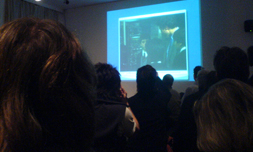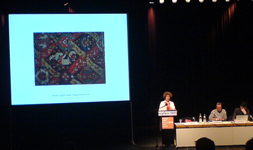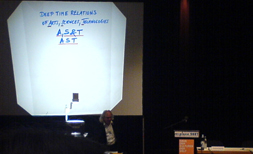| Though I have to admit that my recent complain about Berlin has been proved unreasonable, as I totally overlooked the upcoming re:place 2007 conference, which took place at the House of World Culture during this weekend and I was lucky enough to attend quite a few of the panels, |  |
|
| which definitly submit to some of my better experiences on this field. The first evening’s closing act was Timothy Druckery’s informative and entertaining lecture ‘Cinemedia: Archeologies of Computation an AI in Cinema‘. Along a thread of mov.files he span the history of computation as a thrilling development |
||
| which roots oscillate between genius single characters and ‘societal needs’ (divided between office and military appliances). A nice entertaining highlight was Grace Hopper’s navy stamped narration on the first computer bug. (Guess you should see this here first to understand her bug story better). |  |
|
| The second day started with a panel on Histories of Abstraction and one of my favorites (of those I could attend) was surely Laura Marks’ continuing analysis of | ||
| Artificial life from classical Islamic art to new media art, via 17th-century Holland. It has been another of her careful analysis’ with which she slowly unravels the western blur of perception, to see themselves as predominant and neglect global influences since the earliest times. (listen/view it as a stream) |  |
|
|
… But artificial life has found its way into art – or, I should say, back into art. Presently many artists are working with genetic algorithms to produce art forms that grow, mutate, resolve into new configurations. These artworks have a deep historical precedent in the evolving forms of Islamic art. The nonfigurative patterns of Islamic art have an algorithmic liveliness that prefigures artificial life. I believe it was this implicit life and movement of abstraction that attracted Western artists to Islamic images. Qualities of nonorganic life, self-organization or autopoesis are one fascinating commonality between new media art and much Islamic art.[3] Fixed though they are, Islamic artworks in many media exemplify the generative processes that contemporary algorithmic art carries out in time… (L.Marks’ entire text can be found at heise.de)
|
||
| To end that day with a performative event lecture by S.Zielinski on Deep Time Relations between Arts, Sciences and Technologies, a major research project he has been working on since quite a while – as a concept of questioning established concepts of media. (see also his recent book Deep Time of Media) and publications of the Variantology series. |  |
|
… will be continued ….
